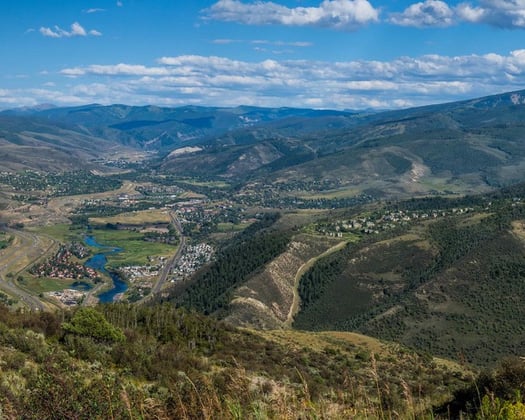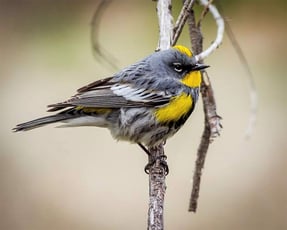Text by Kathryn Middleton
Photos by Rick Spitzer,
For the Eagle County Wildlife Roundtable
Eagle County’s state of wildlife and wildlife populations are directly correlated to the health of our environment. Over the years, expanded recreation and land development have impacted the state of wildlife in Eagle County. Colorado Parks and Wildlife is our local government entity whose mission is to perpetuate wildlife resources, “provide a quality state parks system, and to provide enjoyable and sustainable outdoor recreation opportunities that educate and inspire current and future generations.” Their land conservation teams’ work to nurture healthy landscapes for an interactive coexistence between humans and wildlife today and for future generations (cpw.co.us)
Colorado Parks and Wildlife (CPW) determines population objectives for each species based upon a combination of biological and social thresholds and considerations. Wildlife populations for deer, elk, and many other species are dynamic and influenced by a variety of anthropogenic (human caused) and natural factors. Regardless of human presence, wildlife must live with drought, cold winters, disease, predation, and more.
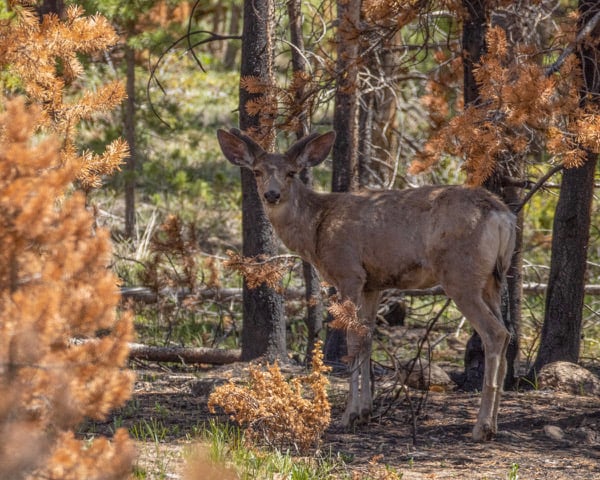
Deer and elk will often move back in to areas burned by fire in the following year to feed on fresh, lush grasses. Some other species can't find food or cover in that area and will not return for years.
However, human presence does complicate survival for wildlife, and the human population in Eagle County has significantly increased in recent decades. The increase in human population has decreased the amount and quality of critical habitat due to infrastructure, traffic, recreation, etc., and the increased number of humans has also spiked the amount and frequency at which wildlife is disturbed or killed. These limitations determine the health and abundance of our wildlife.
For example, the Frying Pan Elk Herd around the year 2000, was at a population of about 12,000 animals, but dropped below 6,000 animals a decade later. Presently, the elk population has stabilized at around 8,000 animals, and has shown difficulty to recover and a lack of young surviving to adulthood.
There have also been declines observed in local deer herds over the past few decades. About 20 years ago, the population of the Brush Creek Deer Herd was roughly 4,000 and now fluctuates at around 2,000-2,500 deer. A significant contributor to these declines has been due to human impact.
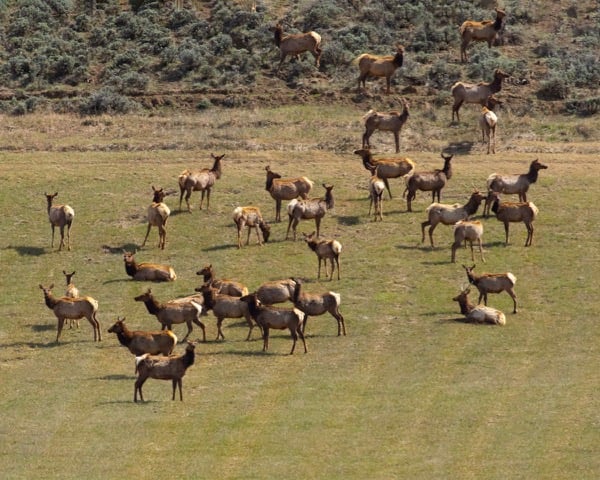
Elk populations have stabilized in some areas, but young elk are having difficulty surviving to adulthood.
Another item of concern in local deer herds has been the increase in presence of Chronic Wasting Disease (CWD), specifically the State Bridge and Sweetwater Deer Herds. CPW has a statewide goal of having 5% or less prevalence of CWD in deer herds; however, the Sweetwater Deer Herd has exceeded that threshold and now sits between 5-10%, and borders herds that have a prevalence of more than 20%. CWD can have lasting effects on herd populations and health, and can also affect other species, such as elk and moose. Between human impacts and natural impacts, it's truly a matter of survival every day for local wildlife.
Recent articles in the Vail Daily by members of the Eagle County Community Wildlife Roundtable (CWR) are intended to inform Eagle County residents about wildlife activity and how our behavior impacts wildlife. CWR and CPW collaborated on a survey entitled “Conservation at the intersection: Examining residents’ perceptions of and preferences for wildlife, outdoor recreation, and development.” It was funded by CPW, and conducted by Mike Quartuch, Ph.D., Human Dimensions Specialist/Researcher, with Colorado Parks & Wildlife - Colorado Department of Natural Resources.
The goal of the survey was to provide data on the attitudes of Eagle County residents about wildlife and wildlife habitat to identify their knowledge, concerns, and land use preferences and incorporate that information into planning efforts and policy decisions. The survey found that overall, a vast majority of residents have positive attitudes toward wildlife, and that sustaining wildlife populations in Eagle County is important (Technical Publication (No. 60)( CPW-R-T-56-20 ISSN 0084-8883)).
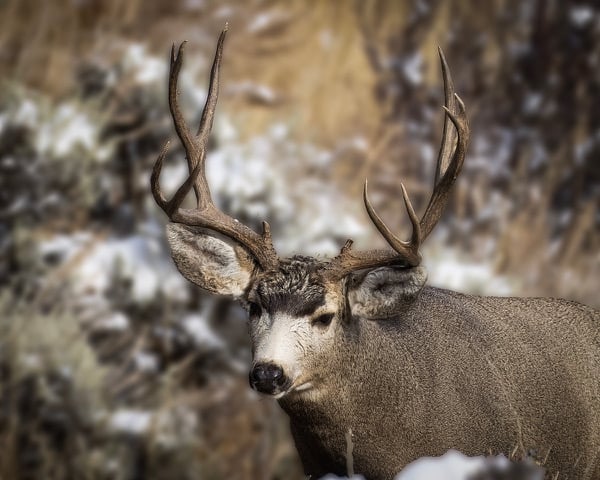
Local deer herds have seen an increase in Chronic Wasting Disease (CWD). This can have a lasting impact on mule deer populations
Historically, elk populations thrived in ranges throughout Eagle County. The Rocky Mountain elk, Cervus elaphus, are one of six elk subspecies and are characterized by their large antlers. Elk habitats vary, but require the basic needs of food, water, space, and shelter for survival. Elk breed in fall during the “rut” and typically give birth in late May through early June. At that time of year, you will see them in social groups of mothers or “cows” along with their offspring of calves and “spikes” (yearling males), bachelor groups or males living alone.
Mule deer, Odocoileus hemionus, characterized by their large ears, are our local deer species. Their ears are almost three-quarters the length of their heads. Mule deer have large dark eyes and muzzles with black foreheads and light gray faces. Their bodies are brownish gray in winter and become tannish brown in summer. Their rumps have white patches with a white tail and a black tip. Their habitat includes arid, rocky environments where they enjoy early-stage plant growth, diverse shrubs and mixed-species plant growth that provide more nutritious forage than mature shrubs and trees.
The Rocky Mountain bighorn sheep, Ovis canadensis, roam our region as well. Bighorn sheep have stocky muscular bodies with chocolate brown fur and white rumps, bellies, and muzzles. They have wide-set eyes with keen eyesight, and they have a keen sense of smell to detect predators. Males have large, curved horns (not antlers) used to compete for females during their mating ritual or “rut”. Females have horns as well, but they are short and only have a slight curve. Bighorn sheep are very agile, they can climb and jump down steep terrain to avoid predation. In summer, they thrive in large upland spaces then move down into sheltered valleys for winter. Their food sources include grasses, clover, and sedges in summer and in winter they forage on woody plants, like willow and sage.
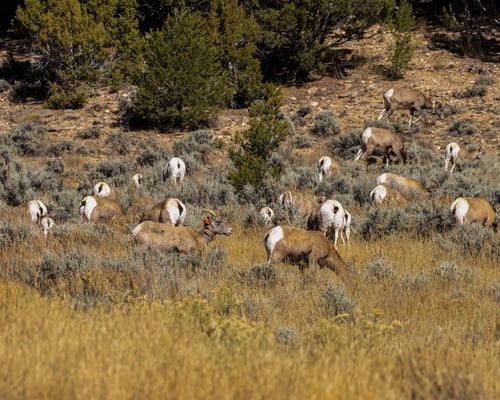
Some local bighorn bands are being studied. Collars are being used to track their behavior and movements in an effort to determine what impact human activity has on those bands.
The state of wildlife in Eagle County includes small mammals, birds, reptiles, and insects that are part of the food chain and ecosystems in our environment. They all contribute to a healthy environment so we should not take them for granted. They are also impacted by human activity and urban development such as trails, roads and bridges that have fragmented their habitat in Eagle County.
Climate change plays a role in the state of wildlife and the ecosystems throughout Eagle County. Big snow years can erode stream banks during spring runoff, and low snow years contribute to drought and wildfire which means that wildlife need to adapt to the changing environment more quickly than in the past. Our presence in the backcountry has also increased, further impacting wildlife habitat. How well, and what we do to reduce our impact will help preserve and protect this natural resource in Eagle County.
Here are a few tips on how we can help keep our wildlife populations and ecosystems healthy and thriving in Eagle County. Respect seasonal road and trail closures, keep pets leashed in the wilderness, and stay on designated trails. If you see wildlife in the area, stay away and alert others. Give them space and don’t scare or feed wildlife, their best chances for survival include our cooperation and understanding of their basic needs. Take the opportunity to get involved and engage with local community efforts and wildlife advocates to learn more. Please enjoy our wildlife, the backcountry and take care, as we are only visitors in these wild places and spaces.
======================================
The Eagle County Community Wildlife Roundtable is a collaborative partnership with the White River National Forest, Colorado Parks and Wildlife, Bureau of Land Management, local government entities, community members, and citizen scientists. The purpose of the Eagle County Community Wildlife Roundtable is to gather a group of diverse stakeholders in the valley to understand and address issues facing wildlife populations. Together we will identify a shared vision and realistic actions that the community can rally around to support wildlife. We want to leverage diverse values, creativity, and resources to move toward positive action.
======================================
